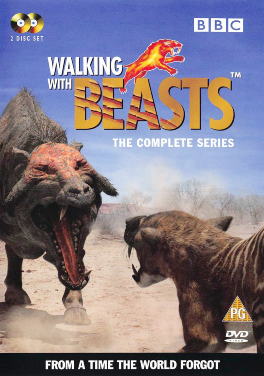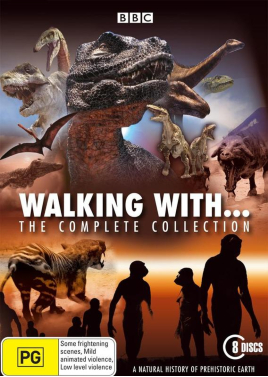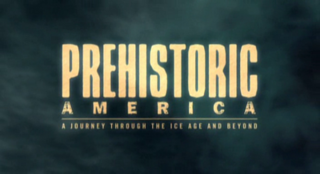
Walking with Cavemen is a 2003 four-part nature documentary television miniseries produced by the BBC Studios Science Unit, the Discovery Channel and ProSieben. Walking with Cavemen explores human evolution, showcasing various extinct hominin species and their inferred behaviours and social dynamics. The original British version of the series is presented by the British researcher Robert Winston; in the American version Winston's appearances and narration is replaced with narration by Alec Baldwin.

Walking with Dinosaurs is a 1999 six-part nature documentary television miniseries created by Tim Haines and produced by the BBC Studios Science Unit, the Discovery Channel and BBC Worldwide, in association with TV Asahi, ProSieben and France 3. Envisioned as the first "Natural History of Dinosaurs", Walking with Dinosaurs depicts dinosaurs and other Mesozoic animals as living animals in the style of a traditional nature documentary. The series first aired on the BBC in the United Kingdom in 1999 with narration by Kenneth Branagh. The series was subsequently aired in North America on the Discovery Channel in 2000, with Avery Brooks replacing Branagh.

Walking with Beasts, marketed as Walking with Prehistoric Beasts in North America, is a 2001 six-part nature documentary television miniseries created by Impossible Pictures and produced by the BBC Studios Science Unit, the Discovery Channel, ProSieben and TV Asahi. The sequel to the 1999 miniseries Walking with Dinosaurs, Walking with Beasts explores the life in the Cenozoic era, after the extinction of the non-avian dinosaurs, particularly focusing on the rise of the mammals to dominance. The UK version of the series is narrated by Kenneth Branagh, who also narrated Walking with Dinosaurs, and the US version is narrated by Stockard Channing.

Walking with Monsters – Life Before Dinosaurs, marketed as Before the Dinosaurs – Walking with Monsters in North America, is a 2005 three-part nature documentary television miniseries created by Impossible Pictures and produced by the BBC Studios Science Unit, the Discovery Channel, ProSieben and France 3. Walking with Monsters explores life in the Paleozoic era, showcasing the early development of groups such as arthropods, fish, amphibians, reptiles and synapsids. Like its predecessors Walking with Dinosaurs (1999) and Walking with Beasts (2001), Walking with Monsters is narrated by Kenneth Branagh.

A nature documentary or wildlife documentary is a genre of documentary film or series about animals, plants, or other non-human living creatures, usually concentrating on video taken in their natural habitat but also often including footage of trained and captive animals. Sometimes they are about wildlife or ecosystems in relationship to human beings. Such programmes are most frequently made for television, particularly for public broadcasting channels, but some are also made for the cinema medium. The proliferation of this genre occurred almost simultaneously alongside the production of similar television series which is distributed across the world.

The Lost World is a 2001 British made-for-television film adaptation of the 1912 novel of the same name by Arthur Conan Doyle, directed by Stuart Orme and adapted by Tony Mulholland and Adrian Hodges. It was filmed at various locations on the West Coast of New Zealand. The 145-minute film was divided into two 75-minute episodes when broadcast on BBC One on 25 and 26 December 2001, receiving 8.68 million and 6.98 million viewers respectively. Bob Hoskins played Professor Challenger and was supported by James Fox, Peter Falk, Matthew Rhys, Tom Ward and Elaine Cassidy.
Shark Week is an annual, week long TV programming block at the Discovery Channel, which features shark-based programming. Shark Week originally premiered on July 17, 1988. Featured annually, in July or early August, it was originally devoted to conservation efforts and correcting misconceptions about sharks. Over time, it grew in popularity and became a hit on the Discovery Channel. Since 2010, it has been the longest-running cable television programming event in history. Broadcast in over 72 countries, Shark Week is promoted heavily via social networks like Facebook and Twitter. Episodes are also available for purchase on services like Google Play Movies & TV/YouTube, Amazon Video, and iTunes. Some episodes are free on subscription-based Hulu and Discovery+.

Nigel Alan Marven is a British wildlife TV presenter, naturalist, conservationist, author, and television producer. He is best known as presenter of the BBC miniseries Chased by Dinosaurs, its sequel, Sea Monsters, as well as the ITV miniseries Prehistoric Park. He is also known for his unorthodox, spontaneous, and daring style of presenting wildlife documentaries as well as for including factual knowledge in the proceedings.

Prehistoric Park is a six-part nature docu-fiction television programme that premiered on ITV on 22 July 2006 and on Animal Planet on 29 October 2006. The programme was produced by Impossible Pictures, who also created Walking with Dinosaurs. Each episode is an hour long including commercial breaks. Repeats of the show are broadcast in the UK on Watch.

Stephen James Backshall is a British naturalist, explorer, presenter and writer, best known for BBC TV's Deadly 60.

Neil Nightingale is a British freelance wildlife filmmaker, executive producer and creative consultant with over 35 years experience at the BBC. From 2009 to 2018 he was the creative director of BBC Earth, BBC Worldwide's global brand for all BBC nature and science content.

Land of Giants and The Giant Claw, marketed together as Chased by Dinosaurs in the United States, are two special episodes of the nature documentary television series Walking with Dinosaurs. Created by Impossible Pictures and produced by the BBC Studios Science Unit, the Discovery Channel and ProSieben, The Giant Claw was first broadcast on 30 December 2002, followed by Land of Giants on 1 January 2003. The two episodes stars British wildlife presenter Nigel Marven as a "time-travelling zoologist", interacting with dinosaurs and other prehistoric creatures, a drastic change in presentation from preceding entries in the Walking with... franchise.

Walking with... is a palaeontology media franchise produced and broadcast by the BBC Studios Science Unit. The franchise began with the series Walking with Dinosaurs (1999), created by Tim Haines. By far the most watched science programme in British television during the 20th century, Walking with Dinosaurs spawned companion material and four sequel series: Walking with Beasts (2001), Walking with Cavemen (2003), Sea Monsters (2003) and Walking with Monsters (2005). Each series uses a combination of computer-generated imagery and animatronics, incorporated with live action footage shot at various locations, to portray prehistoric animals in the style of a traditional nature documentary.

Sea Monsters: A Prehistoric Adventure is a 2007 American IMAX 3D documentary film by National Geographic, about prehistoric marine reptiles. It alternates modern-day sequences about the work of scientists studying the animals with computer-animated scenes depicting the prehistoric past.
Monsters We Met is a documentary produced by the BBC that later aired as a special on Animal Planet in 2004 which also included footage from Walking with Beasts and Walking with Cavemen. The show used computer-generated imagery to recreate the life of the giant animals that lived during the last ice age and explains how early humans encountered them. It also features humans as the main reason for the extinction of all great animals.

Wild New World is a six-part BBC documentary series about Ice Age America that describes the prehistory, landscape and wildlife of the continent from the arrival of humans to the welcome of the Ice Age. It was first transmitted in the UK & JP on BBC Two from 3 October to 7 November 2002. Like several other BBC programmes, it contains both computer graphics and real-life animals. Occasionally, footage of non-American counterparts of the extinct North American beasts are used in juxtaposition with footage of native American animals, like the pronghorn.
Prehistoric Predators was a 2007 National Geographic Channel program based on different predators that lived in the Cenozoic era, including Smilodon and C. megalodon. The series investigated how such beasts hunted and fought other creatures, and what drove them to extinction.
Deadly... is a strand of British wildlife documentary programming aimed principally at children and young people, which is broadcast on CBBC on BBC One and Two and on the CBBC Channel. It is presented by Steve Backshall, with Naomi Wilkinson as co-host on Live 'n Deadly, and Barney Harwood as co-host on Natural Born Hunters. The strand began with a single series known as Deadly 60, and has subsequently expanded into a number of spin-offs, re-edits and follow-up versions.
Jasper James is a British television producer, director and screenwriter. He is well known as the co-creator of several of the Walking with... series.
















